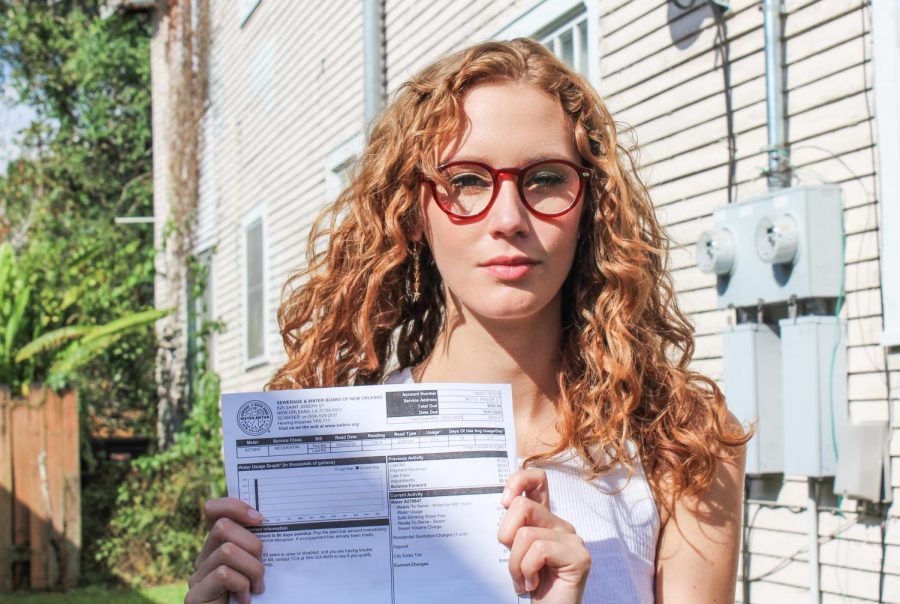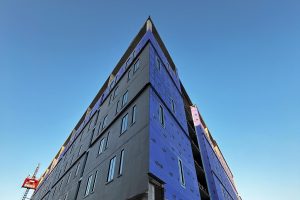Sewerage and Water Board estimates New Orleanians’ bills
Jayme Causey, a new resident of the Broadmoor neighborhood, displays her estimated water bill from the Sewerage and Water Board Oct. 16, 2020. Photo credit: Malik Jamileh
October 31, 2020
Jayme Causey has lived in New Orleans for three years now attending UNO, but just recently leased her first house. When she received her first water bill from the Sewerage and Water Board, it estimated her water usage and, like most residents, she was surprised.
“I could have thought I was dreaming when I opened that bill. I’ve never had a water bill, you know, I just got my first house. But I knew almost $600 seemed a bit high for two months of water so I called them immediately. Who uses that much water?” said Causey.
Residents who receive a high or estimated bill and disagree with the usage cited on the bill can report the issue. Since Causey reported her concerns, she has only been required to pay the minimum on her bill until an agent is able to come out to read her water meter in person to determine her exact usage. But Causey said she has not gotten a time frame on when an agent will be able to visit her home.
“First, I was pissed. Then I called The Sewerage and Water Board with my roommates. The first person hung up on me. The second person was more helpful and told me I only had to pay the minimum requirement until a real read was done. He also told me there were no late fees as well so that was really nice but it’s just the uncertainty,” said Causey.
The New Orleans Sewerage and Water Board has been estimating more than half of resident’s water bills due to staffing shortages from COVID-19.
The COVID-19 pandemic has greatly reduced the Meter Reading Department’s staff, as employees and their colleagues test positive and have to quarantine. The move happened in response to the mayor’s emergency declaration, which brought the workforce down to 20 active meter readers. Meter routes, along with recruitment for vaccines, have been suspended in the department to slow the rate of infection. Meters are being estimated for more than 64% of New Orleans residents according to a statement from The Sewerage and Water Board.
Courtney Barnes, communications director for New Orleans Sewerage and Water Board, said that the billed estimates are based off of residents’ previous water use habits and that it estimating usage is not an uncommon practice.
“An estimated bill means that we bill the customer based on their prior water usage. Should a customer receive an estimated bill, please be aware that it uses a formula built to best predict how much water you use based on what you used previously. If previous rates of water use are unavailable, the estimate will be based on the typical average use for residential properties of 170 gallons a day. Estimations are standard practice in every city and across all American water utilities,” says Barnes.
In mid-August, the board contracted with Olameter, a professional meter-reading organization, to have an additional 20 readers to supplement their staff for 40 hours a week. The Olameter recruits underwent two weeks of training and shadowed staff while learning the unique meter system of New Orleans according to Barnes. They began reading meters Sept. 1.
In addition to contracting with Olameter, the board has implemented a hiring initiative to increase the number of filled meter positions. Currently, there are 36 out of 60 spots filled in the department with an additional 24 new readers that are expected to be trained and on board by the end of the year. Between The Sewerage and Water Board and Olameter teams ,there are 56 current available meter readers in the city, according to Barnes.
The Sewerage and Water Board claims their goal is to read at least 80% of their meters each month. It is important to note that about 20% of meters are inaccessible due to obstruction of parked cars and aggressive dogs. The board anticipates reaching the 80% mark by the end of the year, according to Barnes.
Customers who receive high estimated bills or have questions are encouraged to call 52-WATER.







